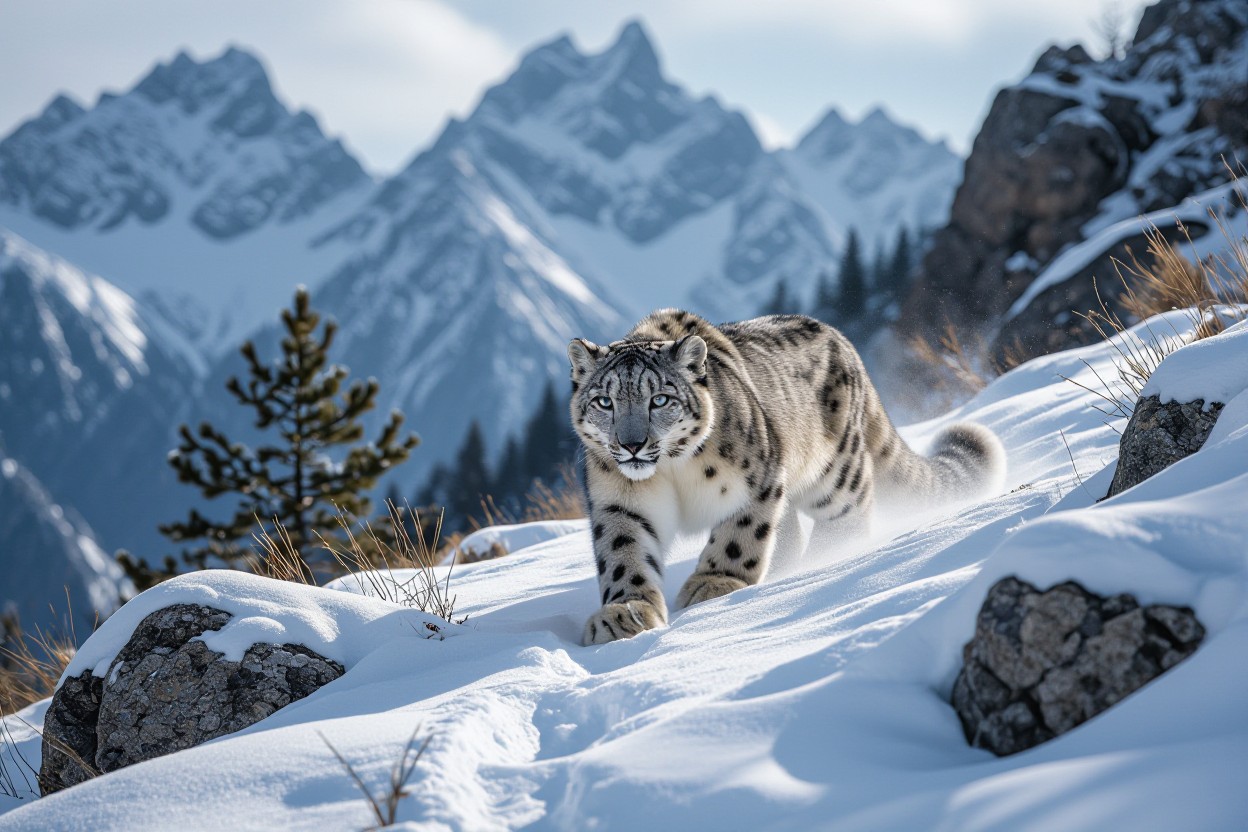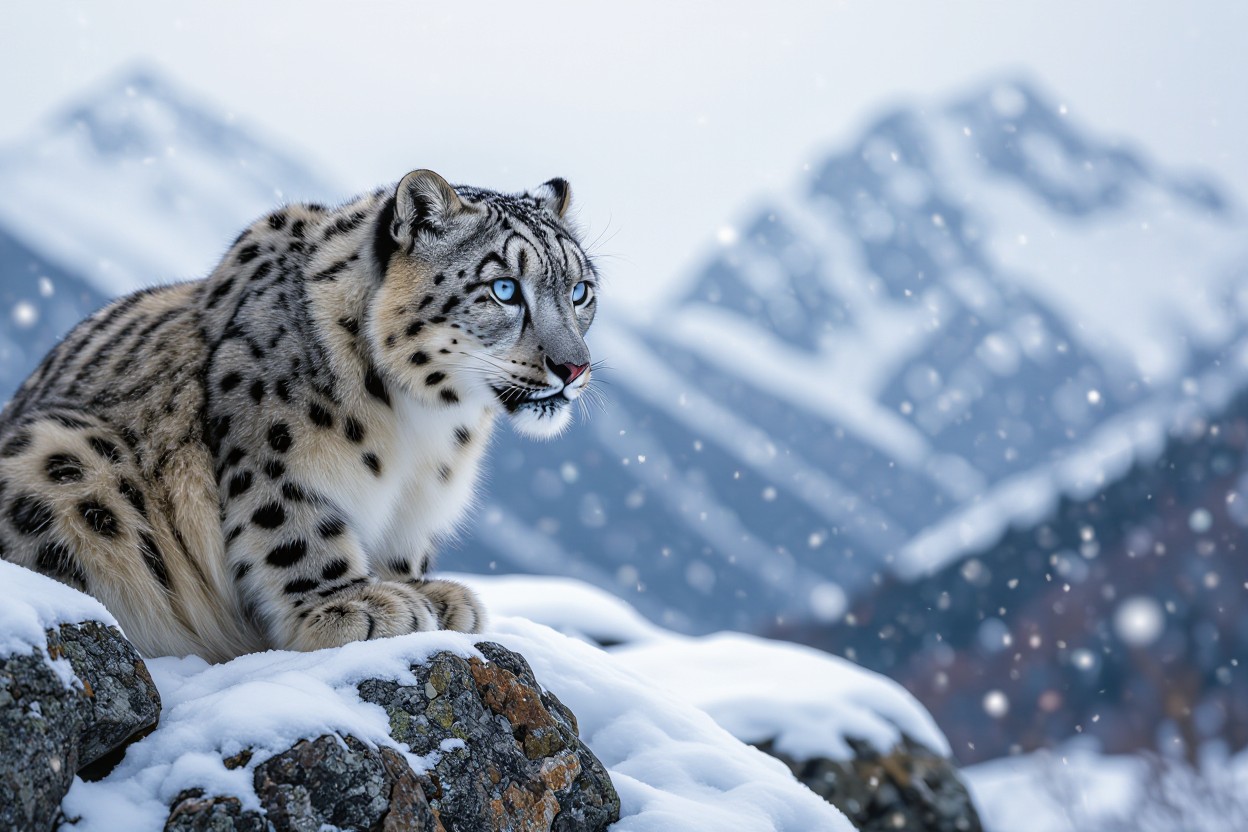Secrets of the snow leopard show you how this shadowy feline survives harsh high-altitude ranges and why your awareness matters: its endangered status and threats like poaching and habitat loss make conservation urgent, while its stealth, resilience, and vital role in mountain ecosystems reveal why protecting it benefits wildlife and people alike.
Key Takeaways:
- Snow leopards are highly elusive, specially adapted to high-altitude terrain, making them hard to study and monitor.
- Habitat loss, declining prey, poaching and climate change threaten populations, so conservation must engage local communities and reduce human-wildlife conflict.
- Camera traps, genetic sampling and community-based monitoring have transformed knowledge of snow leopard ecology and guide targeted protection efforts.
Habitat and Distribution
You find snow leopards in high, broken terrain from alpine meadows to sheer cliffs, typically between 3,000–4,500 m though records span ~1,200–5,500 m. Their habitat is highly fragmented and wild numbers are estimated at about 4,000–6,500 mature animals, so you often encounter them in isolated pockets. They prefer rocky ridgelines and scree where their cryptic grey-white fur and long tail aid ambush, while human encroachment and poaching remain immediate threats.
Geographic Range
You can map snow leopards across about a dozen countries: the Himalayas (Nepal, Bhutan, India), Tibetan Plateau and western China, plus Pakistan, Afghanistan, Tajikistan, Kyrgyzstan, Kazakhstan, Mongolia and Russia’s Altai. Populations are patchy; for example, Nepal’s Annapurna region holds a few hundred individuals while Mongolia’s Sayan and Altai ranges contain isolated groups, producing strong regional genetic structure and local extirpations you may study.
Environmental Adaptations
You observe adaptations for thin air and cold: enlarged nasal cavities warm inhaled air, dense underfur and guard hairs insulate against subzero nights, and broad paws act like snowshoes. Their powerful hind limbs enable leaps of up to 15 m to cross gullies or ambush prey, while the thick, bushy tail supplies balance and is used as a warm wrap when you watch them rest on a ledge.
You’ll notice behavioral tweaks too: they hunt mainly at dawn and dusk to conserve energy, select windward ridgelines to scent-track prey like blue sheep and ibex, and cache kills in crevices to avoid scavengers. In Ladakh some individuals maintain territories exceeding 200 km², while in the Pamirs ranges shrink to tens of km², showing how prey density directly shapes your sightings and conservation priorities.
Physical Characteristics
Unique Features
You’ll note snow leopards combine a compact body (75–120 cm head‑body), weights typically 27–55 kg, and a long tail (80–105 cm) that you see used for balance and warmth. Their powerful hind limbs and wide, partially furred paws let them spring across rocky gullies; large nasal cavities boost oxygen uptake at high altitude. Camera‑trap surveys in Ladakh and the Tien Shan show individuals regularly occupying 3,000–5,500 m.
Coat and Camouflage
Their pelage mixes smoky gray with black rosettes to break your eye’s outline against scree; population variation means rosette size and contrast differ across range. Dense underfur and long guard hairs create effective camouflage and insulation, while seasonal bleaching keeps them less visible in winter. Studies report darker markings in western populations, helping you distinguish individuals in field photos.
Look closer and you’ll find fur on the soles of their paws acting as natural snowshoes, spreading weight and providing traction on ice; their tail doubles as a blanket when curled around the face. The coat withstands alpine extremes—individuals occupy valleys down to −40°C—and molting in spring produces a denser winter coat you can see shedding in late May at lower elevations.

Behavior and Social Structure
Solitary vs. Social Behavior
You mostly encounter snow leopards as loners: adults maintain largely separate ranges — males often occupy 30–50 km² while females hold smaller territories — and only pair briefly for mating. Mothers keep cubs with them for about 12–18 months, teaching hunting and navigation. They communicate with scrapes, scent marks and soft calls; aggressive encounters are rare but can escalate to injury or death when territories overlap.
Hunting and Feeding Patterns
Snow leopards ambush prey from above, using cliffs and ridgelines to launch short, explosive chases; they can leap up to 15 meters to close distance. You’ll see them target wild ungulates like bharal and ibex, but also marmots and hares, with kills often dragged to sheltered ledges. Hunting is solitary and crepuscular, maximizing surprise and minimizing energy spent.
Seasonal shifts matter: you’ll find snow leopards descending in winter to follow herds, sometimes moving over 1,000 meters in elevation. They can tackle prey up to three times their weight and typically cache carcasses on ledges, returning over several days to feed. Livestock predation — sheep and goats — fuels human conflict, so these feeding patterns inform targeted mitigation measures.
Conservation Status
You should know the snow leopard is listed as Vulnerable by the IUCN, with an estimated 4,000–6,500 mature individuals across 12 range countries. Conservation is complicated by your need to balance pastoralist livelihoods and protected-area goals, since populations are fragmented and often occupy transboundary high-altitude terrain where monitoring is difficult and data gaps remain significant.
Threats to the Snow Leopard
Poaching for pelts and bones, livestock depredation leading to retaliatory killings, and expanding mining and road projects drive habitat loss and fragmentation. Climate shifts are forcing prey like blue sheep and ibex to higher elevations, so you face shrinking suitable habitat and increased human-wildlife overlap; illegal trade and weak enforcement in parts of Central Asia further amplify these threats.
Conservation Efforts and Initiatives
Programs led by the Global Snow Leopard & Ecosystem Protection Program (GSLEP) — launched by 12 range countries in 2013 — and NGOs like the Snow Leopard Trust (est. 1981) combine landscape planning, anti-poaching patrols, scientific monitoring and community incentives. You’ll find community-based livestock insurance, predator-proof corrals, and alternative-livelihood projects used widely to reduce killings while expanding camera-trap and genetic surveys for better population estimates.
On-the-ground examples show what works: community insurance schemes that compensate herders for losses, handicraft and eco-tourism enterprises that shift income away from retaliatory killing, and targeted law enforcement in poaching hotspots. You can see success where camera-trap networks and genetic scat analysis have improved population data, and where transboundary GSLEP cooperation secures corridors connecting priority landscapes for long-term viability.
Cultural Significance
In many highland communities across the snow leopard’s 12-country range you encounter deep reverence: it’s woven into oral histories, textiles, and sacred sites, often seen as a mountain guardian. Local festivals in parts of Nepal and Mongolia celebrate rare sightings, while hunters once prized pelts as status symbols. Conservation now frames that cultural value—an estimated 4,000–6,500 mature individuals worldwide makes heritage protection a shared priority against poaching and illegal trade.
Snow Leopard in Local Mythology
Across the Altai, Tien Shan and Himalayan ranges you find stories that cast the snow leopard as both specter and ancestor, guiding hunters and protecting flocks in winter. Shamans in Mongolia invoke its stealth in rites, while Himalayan folktales link it to mountain deities. Because communities feared retaliation after livestock losses, the animal oscillated between worship and persecution, a dual role that shapes how your neighbors still interpret sightings and set local protection rules.
Role in Ecosystem
The snow leopard functions as a keystone predator, keeping populations of bharal (Pseudois nayaur), ibex and marmots in check across alpine meadows; you can trace healthier plant regeneration and sediment retention where predators persist. Research across Nepal and Mongolia links predator presence to lower ungulate overgrazing and greater forb diversity. Yet conflict with herders and reduced prey density are major threats that can trigger cascading degradation of fragile high-altitude landscapes.
Territories often exceed 100 km² in low-prey zones, so you must consider landscape connectivity: camera-trap studies show leopard movements span multiple protected areas and community lands. Diet studies report mostly medium-sized ungulates in the 20–70 kg range, meaning prey declines force leopards into livestock predation; programs that restore native prey and fund predator-proof corrals have been shown to cut conflict and stabilize local trophic networks in Ladakh and parts of Central Asia.
Research and Monitoring
Methods of Study
Using large-scale camera-trap networks (over 1,200 stations in coordinated projects), you combine occupancy models with spatial capture-recapture to estimate densities; GPS collars that transmit locations every 3–6 hours reveal home ranges of ~30–200 km² and seasonal movements; non-invasive genetics from scat and snow with 10–12 microsatellite markers let you ID individuals and kinship; and community-based patrols and herd-loss reporting provide socio-economic context, so your assessments link animals, threats, and people.
Recent Findings
Multi-site syntheses now place global numbers at roughly 4,000–6,500 adults and confirm coordinated monitoring across 12 range countries; telemetry shows typical ranges of 30–200 km² and altitudinal shifts of 200–500 m in parts of the Himalaya tied to warming and prey movement; diet analyses find >50% wild ungulates in protected landscapes, while livestock-dominant zones report higher depredation, giving you clear targets for corridor protection and conflict mitigation.
In Mongolia’s Tost, long-term GPS-collar and camera-trap work documented seasonal movements up to 100 km and mapped wintering valleys; pairing telemetry with community ranger reports exposed poaching hotspots and enabled targeted patrols that reduced illegal kills. Genetic match-ups there clarified relatedness and connectivity, letting you prioritize corridors and scale similar multi-method approaches elsewhere for actionable management.
Summing up
From above the rugged ranges, the Secrets of the Snow Leopard reveal how this elusive predator survives extreme altitudes, blends into harsh terrain, and navigates sparse prey and human pressures; by understanding its behavior, habitat needs, and the conservation measures that work, you gain the basis to support effective protection, shape policy, and make informed decisions that help secure its future.
FAQ
Q: What is “Secrets of the Snow Leopard” about?
A: “Secrets of the Snow Leopard” explores the natural history, behavior, and ecology of the snow leopard across its high‑altitude range in Central and South Asia. It combines field footage of hunting and territorial behavior with accounts of seasonal movements, physiological and camouflage adaptations for cold, and the species’ role in fragile mountain ecosystems. The program also profiles the scientists and local communities involved in monitoring and protecting these cats.
Q: How reliable are the scientific claims presented in the film/book?
A: The work draws on peer‑reviewed studies and field data such as camera‑trap records, GPS telemetry, genetic analyses, and long‑term population monitoring by conservation organizations. Interpretive segments may simplify complex topics for broad audiences, but major behavioral and ecological claims are grounded in published research and interviews with specialists in carnivore ecology and mountain conservation.
Q: What practical steps can viewers take to help snow leopard conservation?
A: Support reputable conservation groups that fund anti‑poaching patrols, community‑based livestock compensation or insurance schemes, and habitat protection; choose tour operators that follow best practices for low‑impact mountain tourism; avoid products linked to illegal wildlife trade; donate to or volunteer with scientific monitoring and community development programs; and raise public awareness about the species’ plight and the need for cross‑border conservation policies.

